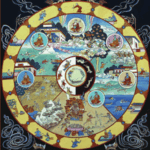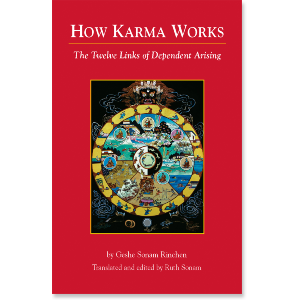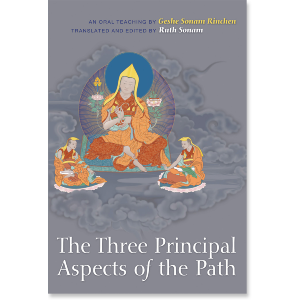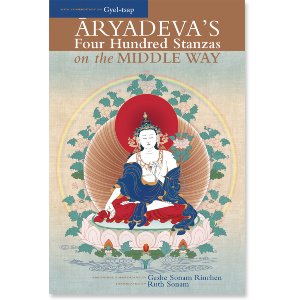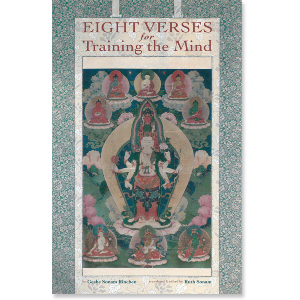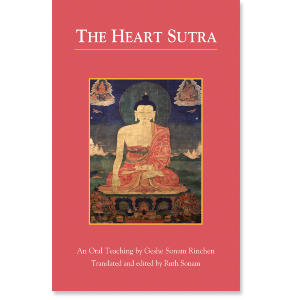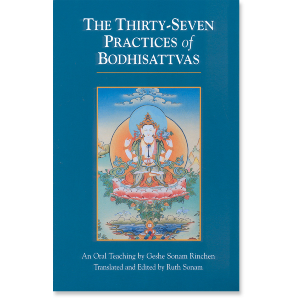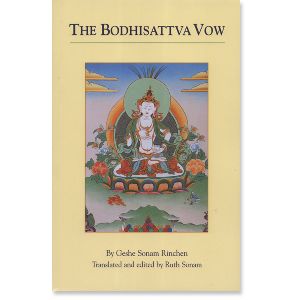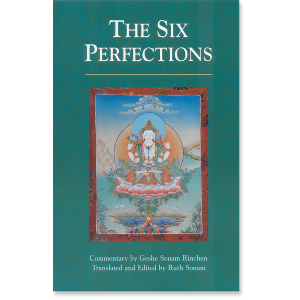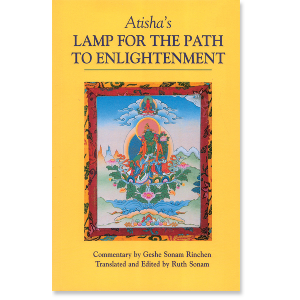
$22.95 - Paperback
An Oral Teaching by Geshe Sonam Rinchen
We all want to find happiness and be free from suffering. The twelve-part process of dependent arising shows how actions underlain by ignorance propel us from one rebirth into another, keeping us trapped in suffering, and how through understanding reality correctly we can break this cycle. The following three excerpts from How Karma Works by Geshe Sonam Rinchen, a well-known teacher in Dharamsala, are based on the Rice Seedling Sutra and the twenty-sixth chapter of Nagarjuna’s Treatise on the Middle Way.
Conditioned by formative action,
Consciousness enters rebirths.
When consciousness has entered,
Name and form come into being.
A variety of causes and conditions produce each moment of consciousness, but here Nagarjuna emphasizes how formative action determines which kind of rebirth the consciousness will enter. How does consciousness continue on? It does so when the death process is complete and the moment of death occurs. This is simultaneous with the beginning of the intermediate state. In the case of a human rebirth, the being of the intermediate state ceases to exist at the moment when consciousness enters the fertilized ovum in the womb of the mother. The end of the intermediate existence and the beginning of the human existence are simultaneous. The final moment of the death process is like deep sleep; the intermediate state is like dreaming and conception like waking.
The fourth link, name and form, describes the moment of conception. “Name” refers to the four aggregates of feeling, discrimination, compositional factors, and consciousness, while “form” refers to the physical embryo. The entity of the being has come into existence, after which development takes place.
Just as barley seed or rice seed yield their own specific crop, the imprints implanted on consciousness through performing actions yield their own particular results in the form of good or bad rebirths. When rebirth in the desire realm or form realm occurs, all five aggregates are present from the very beginning. In the formless realm the four aggregates associated with mental activity are present, but since beings in that realm have no actual physical form, the physical aspect is present only as a potential.
∗ ∗ ∗
Experience and Response
The next verses of Nagarjuna’s text show how the capacity to experience arises and how response to experience takes place while the unborn child is growing.
When name and form have come into being,
The six sources emerge.
In dependence on these six sources
Contact properly arises.
Gradually the fetus develops and the six sources—from the eye sense faculty to the mental faculty—are formed. The bases for these faculties are there from the outset, but this link is called the six sources because now the sources have developed and can function. The mental faculty and mental consciousness in a subtle form are present from the moment of conception.
At conception the entity of the living being came into existence. The attributes of that living being emerge with the development of the six sources and it now becomes a user of things, namely one who can engage with things. All of this is the maturation of an action performed in the past.
What are the conditions that give rise to contact? In the third verse Nagarjuna underlines the vital role played by the faculties when he writes, “In dependence on these six sources contact properly arises.”
∗ ∗ ∗
A Gift for a King
During the Buddha’s lifetime there was a king called Bimbisara who, it is said, struck up a relationship with another king called Utrayana. Utrayana lived in a rather remote place and, although the two kings had never met, messengers went back and forth between them. On one occasion King Utrayana sent King Bimbisara a very precious and special jewel. It had the power to give a feeling of well-being and to remove poison when touched.
Since the jewel was priceless, this gift proved quite an embarrassment to King Bimbisara, who felt obliged to send a gift of equal value. His ministers tried to estimate the value of the jewel, but when they calculated it in gold coins, it turned out to be ten million. How could they reciprocate with a gift worth ten million gold coins? They could think of no solution. King Bimbisara was despondent and retired to a darkened room. He took off his normal finery and lay down on his bed. Seeing this, one of his ministers, who was a Brahmin, suggested to the king that he should consult the Buddha.
The Buddha’s advice was simple: he told Bimbisara to send King Utrayana a painting of himself, the Buddha. A number of painters were summoned and it was decided that the best painting would be chosen as the gift. Some versions of the story recount that when the painters saw the Buddha, they could not stop gazing at him and were quite unable to begin painting. This once again depressed King Bimbisara, but the Buddha solved the problem by using his radiance to project his image onto their canvases. Other accounts say that the Buddha’s radiance was so powerful that the painters were dazzled and could not paint him, so he told them to look at his reflection in a pool.
The best image was chosen and the Buddha instructed the painter to depict the twelve links of dependent arising around the edge of the painting. Some verses about this twelve-part process were written at the bottom. The painting was wrapped in many layers of costly silks and brocades. It was carefully placed in a golden box and dispatched to the king, but it was preceded by a letter to him.
The letter announced to King Utrayana that King Bimbisara was sending him a gift that transcended all other gifts in the world. In order to receive it properly he should prepare the road leading to his city and palace by having it cleaned for several miles, and that he and his retinue should welcome it with great ceremony and offerings.
When King Utrayana saw this letter, he felt irritated and insulted by its tone of command, and he remarked to his ministers that he would prepare his troops for battle. But the ministers, who were rather more circumspect and sensible, suggested that it might be a wiser policy first to see what the gift was and then, if it didn’t please the king, they could make ready for war. So preparations were made to receive the gift in the manner described by King Bimbisara.
They escorted it ceremonially into the palace. Then, with the whole court waiting in suspense, it was taken out of the golden box. To everyone’s surprise, when the many layers of silk and brocade had been removed, what lay before them was a rolled-up painting. Eagerly they unrolled it and found a beautiful portrait of someone they did not know. Present at court, however, were some merchants who had visited Magadha, the area where Bimbisara lived, and they recognized that it was a painting of the Buddha. At once they began speaking words in praise of the Buddha and paid homage to him. King Utrayana and his court had already been prepared for something exceptional. Moved by the image and by the reverence of the merchants, they were quite overcome.
Through the arrival of this gift past positive imprints were awakened in the king and his court. The king took the painting to his private quarters. That evening he looked carefully at the twelve images around the edge and read the verses. Throughout the night he thought very deeply about this whole twelve-part process in forward and reverse sequence, and in the course of this intensive meditation he reached the stage of a stream enterer, that is, he had direct perception of the truth. It is said that even just seeing these twelve links depicted creates beneficial imprints, so thinking about them again and again with understanding of how they function will undoubtedly have a very profound effect and bring vast benefit.
The King of Meditative Stabilizations Sutra says that even if we look at the image of a Buddha when we are angry, negativity created over many aeons is purified. If that is true, we can easily imagine how much negativity is purified and how much virtue created when we look at such an image with faith in our hearts, make a gesture of homage as an expression of that faith and speak words of praise. The four noble truths, the twelve links of dependent arising and the two truths regarding conventional and ultimate reality, all interrelated, form the very core of the Buddha’s teaching. The many different practices of sutra and tantra become meaningful and purposeful only when they are based on a good understanding of these fundamental and seminal principles.

